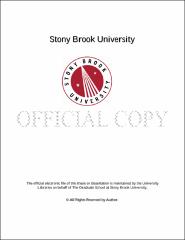| dc.identifier.uri | http://hdl.handle.net/11401/77076 | |
| dc.description.sponsorship | This work is sponsored by the Stony Brook University Graduate School in compliance with the requirements for completion of degree. | en_US |
| dc.format | Monograph | |
| dc.format.medium | Electronic Resource | en_US |
| dc.language.iso | en_US | |
| dc.publisher | The Graduate School, Stony Brook University: Stony Brook, NY. | |
| dc.type | Dissertation | |
| dcterms.abstract | The inherent drug resistance of Mycobacterium tuberculosis (Mtb) has been attributed in part to the low permeability of its asymmetric outer membrane, which consists of extremely long-chain mycolic acids intercalated with a variety of distinctive surface lipids such as polyacyltrehalose (PAT) and phthiocerol dimycocerosate (PDIM). The biosynthesis of these virulence-associated lipids requires acylation by polyketide-associated protein acyltransferases (PapA). We show that PapA5 is the terminal enzyme in PDIM biosynthesis by demonstrating its dual esterification activity and chain-length preference with synthetic alkyl beta-diol substrate analogues. We also demonstrate that PapA5 is phosphorylated by Mtb kinases PknB and PknE which suggests that post-translational modification may regulate PDIM biosynthesis. Analogously, PapA3 acylates trehalose to form diacyltrehalose (DAT), but the downstream enzyme(s) that generate the final product, PAT, have not been identified. We provide evidence that the serine hydrolase Chp2 is essential for the final steps of PAT biosynthesis and its activity appears to be regulated by the putative lipid transporter MmpL10. In comparison to biosynthesis, little is known about lipid transport between the inner and outer membranes. In order to identify proteins that may be involved, we initially explored a chemoenzymatic strategy to generate reactive crosslinking lipid analogues. We examined the enzymatic synthesis of various acyl-CoAs by the fatty acyl-CoA ligase FadD6 as in vitro substrates for PapA family enzymes. While FadD6 is capable of generating substrates in situ for PapA3 and PapA5, this is not an ideal method for generating lipid analogues due to low product yield. In other work, we characterized LppX, which has been implicated in transporting PDIM to the outer membrane. We developed a competitive fluorescence reporter assay to characterize LppX-ligand binding and thereby provide insights into PDIM recognition by LppX. LprG, a homolog of LppX, is also required for Mtb virulence and has been implicated in triacylglyceride (TAG) transport and lipoarabinomannan (LAM) display at the cell surface. We hypothesized that LprG interacts with other cell wall proteins in the process of transporting lipids between membranes. Using complementary crosslinking methods, we identified several LprG-interacting proteins that may contribute to lipid trafficking and corroborate LprG involvement in mycobacterial membrane biogenesis. | |
| dcterms.available | 2017-09-20T16:51:52Z | |
| dcterms.contributor | Carrico, Isaac | en_US |
| dcterms.contributor | Seeliger, Jessica C | en_US |
| dcterms.contributor | Tonge, Peter | en_US |
| dcterms.contributor | Thanassi, David. | en_US |
| dcterms.creator | Touchette, Megan Ann | |
| dcterms.dateAccepted | 2017-09-20T16:51:52Z | |
| dcterms.dateSubmitted | 2017-09-20T16:51:52Z | |
| dcterms.description | Department of Chemistry. | en_US |
| dcterms.extent | 203 pg. | en_US |
| dcterms.format | Monograph | |
| dcterms.format | Application/PDF | en_US |
| dcterms.identifier | http://hdl.handle.net/11401/77076 | |
| dcterms.issued | 2015-05-01 | |
| dcterms.language | en_US | |
| dcterms.provenance | Made available in DSpace on 2017-09-20T16:51:52Z (GMT). No. of bitstreams: 1
Touchette_grad.sunysb_0771E_12493.pdf: 12047727 bytes, checksum: ee6c0f1a1199594bcd77e9595f0d9ad4 (MD5)
Previous issue date: 2015 | en |
| dcterms.publisher | The Graduate School, Stony Brook University: Stony Brook, NY. | |
| dcterms.subject | membrane biogenesis, Mycobacterium tuberculosis | |
| dcterms.subject | Chemistry | |
| dcterms.title | Exploration of Lipid Biosynthesis and Transport Mechanisms in Mycobacteria | |
| dcterms.type | Dissertation | |

